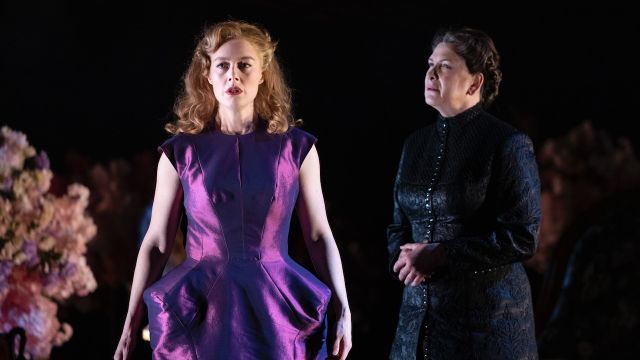Rebecca
This sumptuous adaptation preserves all the fundamental elements of De Maurier’s novel whilst also acknowledging its contemporary relevance. This is achieved by de-contextualising the setting visually. Locations are still referred to in the text, but the set design (Marg Horwell) is more suggestive of the locations rather than attempting to recreate them. This is particularly effective as the set design incorporates some stunning elements that make a great aesthetic impact. The costume design (Marg Horwell) is also mostly quite timeless.
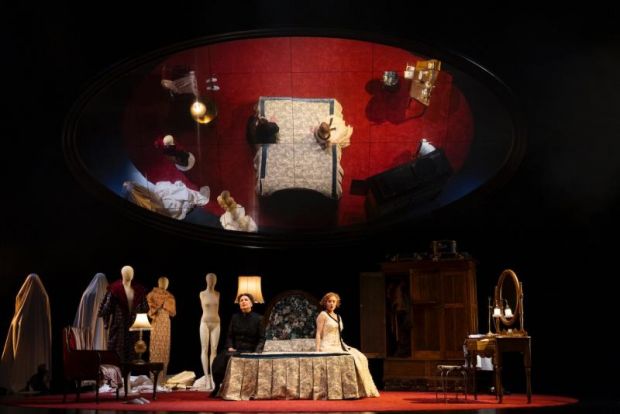
When the marriage begins to turn sour as the truth about Rebecca is revealed, Maxim’s (Stephen Phillips) behaviour is clearly cast as intimate partner violence. He is physically violent and also his behaviour exhibits shades of coercive control. This adaptation is not afraid to draw out these kinds of complexities and to examine the darker side of the characters.
The unnamed Woman is played beautifully by Nikki Shiels who carries a very convincing air of naivety. The production emphasises her gradual transformation into Rebecca and Shiels makes this change in gradual and subtle ways that accentuate the haunting presence of Rebecca. Pamela Rabe as Danvers is phenomenal. She plays three roles (Mrs Van Hopper/Mrs Danvers/Beatrice), and each persona is, to some extent, an antagonist for the Woman. Her transition from one character to the other is often astonishing and a delight to witness. The dramatic change in her vocal tone, accent and demeanour are very striking.
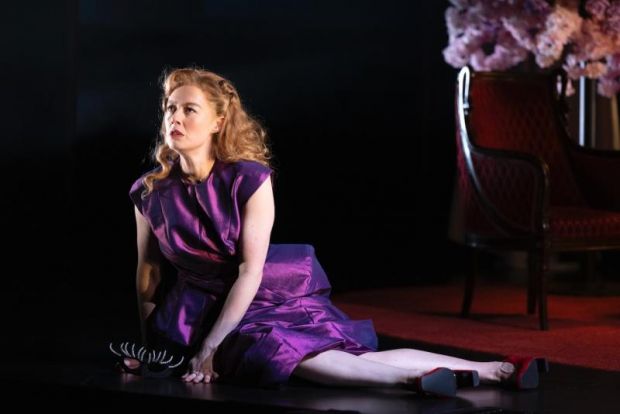
The tension between Danvers and the Woman reverberates in every single line. Danvers has a very ghostly appearance, often emerging out of or disappearing into the shadows. This helps to fuel the tension and gives her a very ominous aura. Her devotion to Rebecca is also made explicit and her lesbian desire is made unequivocal in that adoration.
As the play progresses it is mainly set in Rebecca’s bedroom. Here the set becomes more detailed and incredibly lavish. The staging also allows for some extremely clever and effective set changes that indulge the dream-like quality of the unfolding mystery. The richness of the set is impressive and it often looks quite exquisite. This also emphasises the importance of the myth of class and beauty surrounding Rebecca and Manderley.
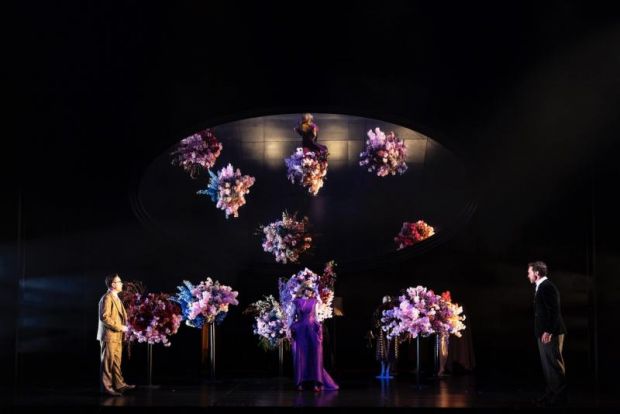
This production provides a very indulgent experience that takes you into the very depths of Du Maurier’s novel and her very forward-thinking ideas. It highlights the gender and class divisions she so expertly explored and critiqued. The production makes it very clear that, in many respects, the often vengeful and spiteful nature of these divisions has not changed much since Du Maurier first put these ideas down onto paper.
Patricia Di Risio
Photographer: Pia Johnson
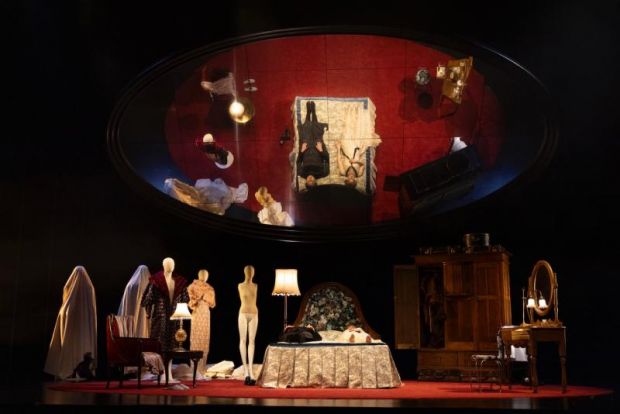
Flora Georgiou also reviewed Rebecca. Her review follows.
The play Rebecca begins with a woman narrating her own story, replicating the opening of the Daphne Du Maurier novel (1939): “Last night l dreamt l went to Manderley again….” and the screen adaptation, directed by Alfred Hitchcock (1940).
The narrator continues, “… occluded night, where dreams and reality blur; the maddening loop of time and memory; the house as refuge and prison, pulling the inhabitants back into the murky waters of the past”.
Our narrator (Nikki Shiels) begins her story where it ends, somewhere in Monte Carlo where the rich and famous take holidays. Now a devoted wife to Maxim de Winter (Stephen Phillips), when once she was a working companion to the gossipy New Yorker, Mrs Van Hopper (hilarious characterisation performed by Pamela Rabe), who introduced her by chance to Maxim, some many summers ago. Sets and costumes (designed by Marg Howell) seemingly arranged in the tea rooms of an opulent hotel for these scenes.
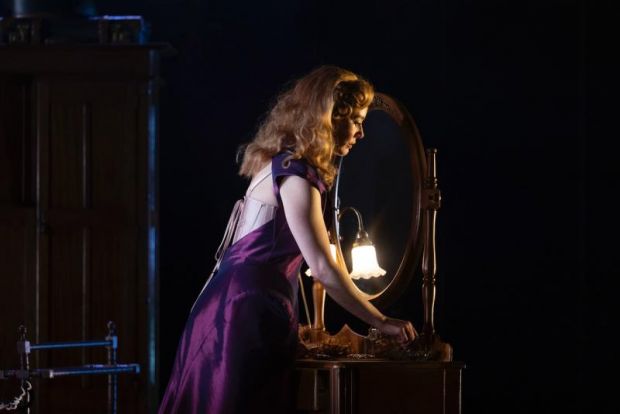
Anne-Louise Sarks has directed the first stage adaptation of the novel. Her calculated gothic melodramatic twists evoke a gloomy melancholia, conjuring intrigue and mystery. Sparks unfolds a complex story with augmented theatrical devices based on filmic methods (Hitchcockian in style) fades to black, dissolves into darkness and jump cuts used effectively to unravel the story of Rebecca.
Shiels gives an outstanding performance as the sweet, dowdy innocent in her pale-coloured knits, with her insipid apologetic manner. As the play moves forward, she becomes a stronger and more engaging character with depth and purpose, in earnest haste to save her tempestuous marriage.
Yet she feels trapped in a mysterious cycle while learning haphazardly how to rule the house as Mistress of Manderley, shadowed by her sinister housekeeper Mrs Danvers (Pamela Rabe) performed with outstanding morbid finesse including the fetishist fondling of the silk nightgown and fluffy slippers that once belonged to Rebecca, only to creep and frighten our narrator (Shiels).
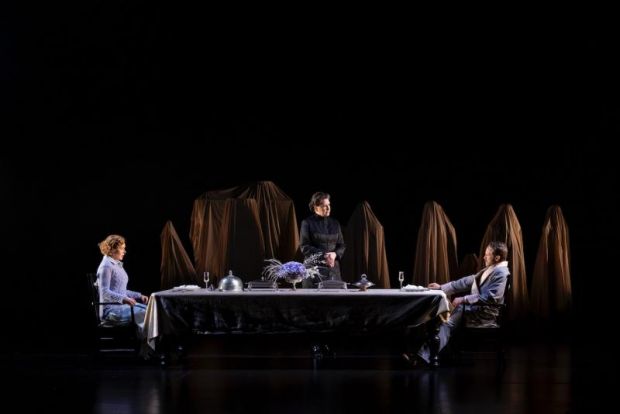
Sarks has meticulously crafted a stunning crescendo that takes place during the Masquerade ball. The housekeeper Mrs Danvers manipulates the desperate young mistress into wearing the gown worn by Rebecca in the painted portrait that hangs in the family gallery.
Maxim lashes into a violent physical attack striking her (Shiels) when he sees her in Rebecca’s dress. It results in an unforeseen outcome where confessions, revelations and a significant point of no return for our narrator - unleashes nightmarish, psycho-sexual behaviour including a barrage of voice over, flashbacks and time jumps that culminate in a reinvention of her persona and a reconciliation with Maxim. Phillips is exquisite as the taciturn, mood swinging husband who has been thrown into mental turbulence by the supposed mysterious death of his first wife and married in haste a woman of a lower class.
The sound design and composition (Grace Ferguson and Joe Paradise Lui) are superbly orchestrated and are paired effortlessly with lighting design (Paul Jackson) to enhance the change of dramatic events. Howell’s set for the latter scenes reflects trauma, morbid-decay that revolves around the master bedroom (symbolic and surreal dreamlike moss - green plant creepers and a huge oval mirror that hovers above), reflecting on the past and posing a chance for renewal.
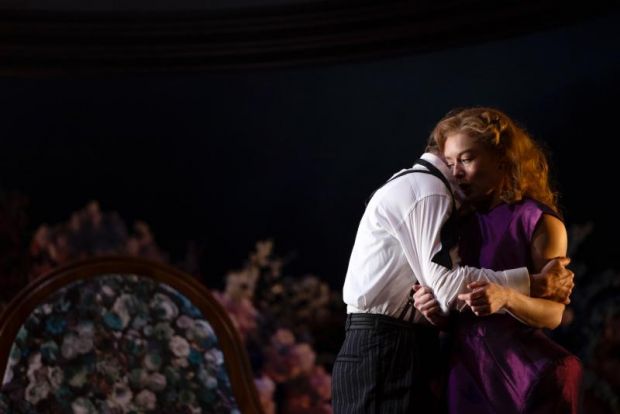
A hilarious caricature of Maxim’s snooty sister Beatrice (Pamela Rabe) berating the new mistress for her lack of style and flair is quaintly comical as is Jack (Toby Truslove), Rebecca’s first cousin, a cheeky and charming playboy. Truslove doubles up as Frank, Maxim’s financial manager. They are colourful characters, offering comic relief in the gloom and doom of Manderley, as do the colourful abundance of big flower arrangements (Howell’s set design) that give wonderful depth, simulate vast rooms and reflect the vibrant freshness in favour of our narrator (Shiels).
Our narrator’s marriage with Maxim may be saved and the death of all that is Rebecca and all that is Manderley is destroyed, as they spend the rest of their time back in Monte Carlo, she as his forever companion.
Sarks and her team have created a whopper of show, featuring challenging technical ideas that experiment with narrative and offer new perspectives on a classic, much-loved novel.
Flora Georgiou
Subscribe to our E-Newsletter, buy our latest print edition or find a Performing Arts book at Book Nook.

